Table 12 Fuel Consumption Factors for Road Transport (in g fuel/km)
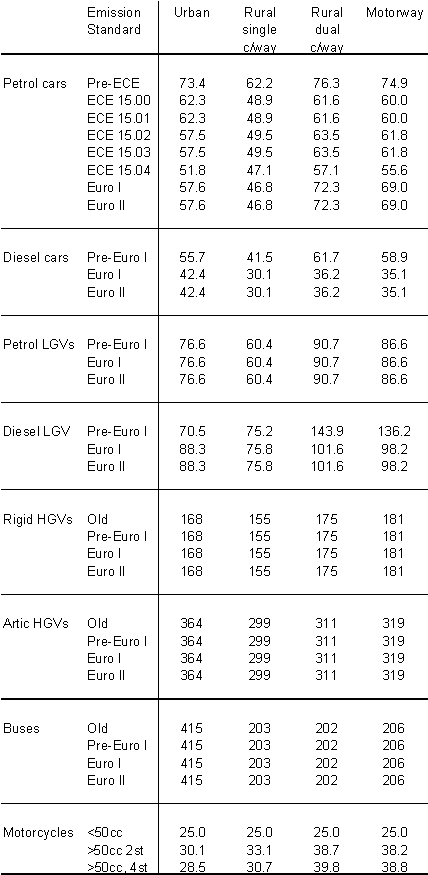

Emissions from road transport are calculated either from a combination of total fuel consumption data and fuel properties or from a combination of drive related emission factors and road traffic data.
Improvements to the 1999 inventory
For the 1999 inventory, the main improvements have been in the use of more up-to-date VOC speciation profiles for benzene and 1,3-butadiene in exhaust emissions. The new speciation profiles are taken from COPERT III (European Environment Agency, 2000). Changes to the timeseries road traffic emissions also arise from slight revisions in the vehicle kilometre figures used, as published in "Transport Statistics Bulletin - Road Traffic Statistics: 1999" (DETR, 2000a)
Emissions of carbon dioxide, sulphur dioxide and black smoke from road transport are calculated from the consumption of petrol and diesel fuels and the sulphur content of the fuels consumed. Data on petrol and diesel fuels consumed by road transport in the UK are taken from the Digest of UK Energy Statistics published by the DTI and corrected for consumption by off-road vehicles.
In 1999, 21.5 Mtonnes of petrol and 15.2 Mtonnes of diesel fuel (DERV) were consumed in the UK. It was estimated that of this around 0.9% of petrol was consumed by off-road vehicles and machinery, leaving 21.3 Mtonnes of petrol consumed by road vehicles in 1999. Around 87% of the petrol sold in the UK was unleaded.
Emissions of CO2, expressed as kg carbon per tonne of fuel, are based on the H/C ratio of the fuel; emissions of SO2 are based on the sulphur content of the fuel. Values of the fuel-based emission factors for CO2 and SO2 from consumption of petrol and diesel fuels are shown in Table 11. SO2 emission factors vary annually as the sulphur-content of fuels change and are shown in Table 11 for 1999 fuels based on data from UKPIA (2000). 1999 saw a significant reduction in the average sulphur content of diesel fuel consumed due to increased penetration of ultra-low sulphur diesel in filling stations.
Table 11 Fuel-Based Emission Factors for Road Transport in kg/tonne fuel
|
Ca |
SO2b |
Black smokec |
|
|
Petrol |
855 |
0.473 |
0.20 |
|
Diesel |
857 |
0.145 |
8.3 |
a Emission factor in kg carbon/tonne, based on UKPIA (1989)
b 1999 emission factor calculated from UKPIA (2000) figures on the weighted average sulphur-content of fuels delivered in the UK in 1999
c Keddie et al (1978); Timmis et al. (1988). Note that for diesel vehicles, the effective emission factor was reduced relative to earlier values in line with reductions in particulate emissions from heavy duty vehicles in the UK fleet since 1992. The effective emission factor for petrol vehicles were decreased relative to earlier values in line with reductions in the average particulate emission factor for these vehicles due to the phasing out of leaded petrol and penetration of three-way catalysts in the fleet.
Emissions of CO2 and SO2 can be broken down by vehicle type based on estimated fuel consumption factors and traffic data in a manner similar to the traffic-based emissions described below for other pollutants. The 1999 inventory used fuel consumption factors expressed as g fuel per kilometre for each vehicle type and average speed calculated from the emission functions and speed-coefficients provided by COPERT II (European Environment Agency, 1997). Average fuel consumption factors calculated from these functions are shown in Table 12 for each vehicle type, emission regulation and road type in the UK. A normalisation procedure was used to ensure that the breakdown of petrol and diesel consumption by each vehicle type calculated on the basis of the fuel consumption factors added up to the DTI figures for total fuel consumption in the UK (adjusted for off-road consumption).
Emissions of the pollutants NMVOCs, NOx, CO, CH4 and N2O are calculated from measured emission factors expressed in grammes per kilometre and road traffic statistics from the Department of Environment, Transport and the Regions (DETR, 2000a). The emission factors are based on experimental measurements of emissions from in-service vehicles of different types driven under test cycles with different average speeds. The road traffic data used are vehicle kilometre estimates for the different vehicle types and different road classifications in the UK road network. These data have to be further broken down by composition of each vehicle fleet in terms of the fraction of diesel- and petrol-fuelled vehicles on the road and in terms of the fraction of vehicles on the road made to the different emission regulations which applied when the vehicle was first registered. These are related to the age profile of the vehicle parc.
Emissions from motor vehicles fall into three different types which are each calculated in a different manner. These are hot exhaust emissions, cold-start emissions and, for NMVOCs, evaporative emissions.
Exhaust emissions of benzene and 1,3-butadiene are calculated by applying speciation mass fractions to the NMVOC emission factors. Values for different categories of vehicles and fuels were taken from COPERT III.
Exhaust emissions of particulate matter, as PM10, from vehicles are also calculated from emission factors and traffic data, but different procedures are used for estimating emissions from petrol and diesel vehicles. Particulate emissions from tyre and brake wear are also estimated from emission factors and traffic data.
Measured PAH emission factors for road vehicles are sparse, but are available for some types of vehicles. For other types of vehicles, emission factors for each PAH species have been estimated according to the way the exhaust emissions of particulate matter vary between each type of vehicle.
Table 12 Fuel Consumption Factors for Road Transport (in g fuel/km)

Hot exhaust emissions
Hot exhaust emissions are emissions from the vehicle exhaust when the engine has warmed up to its normal operating temperature. Emissions depend on the type of vehicle, the type of fuel its engine runs on, the driving profile of the vehicle on a journey and the emission regulations which applied when the vehicle was first registered as this defines the type of technology the vehicle is equipped affecting emissions.
For a particular vehicle, the drive cycle over a journey is the key factor which determines the amount of pollutant emitted. Key parameters affecting emissions are the acceleration, deceleration, steady speed and idling characteristics of the journey, as well as other factors affecting load on the engine such as road gradient and vehicle weight. However, work has shown that for modelling vehicle emissions for an inventory covering a road network on a national scale, it is sufficient to calculate emissions from emission factors in g/km related to the average speed of the vehicle in the drive cycle (Zachariadis and Samaras, 1997). Emission
factors for average speeds on the road network are then combined with the national road traffic data.
Vehicle and fuel type
Emissions are calculated from vehicles of the following types:
Total emission rates are calculated by multiplying emission factors in g/km with annual vehicle kilometre figures for each of these vehicle types on different types of roads.
Vehicle kilometres by road type
Hot exhaust emission factors are dependent on average vehicle speed and therefore the type of road the vehicle is travelling on. Average emission factors are calculated for average speeds on four specified types of roads and combined with the number of vehicle kilometres travelled by each type of vehicle on each of these road types:
DETR estimate annual vehicle kilometres for the road network in Great Britain by vehicle type on roads classified as trunk, principal and minor roads in built-up areas (urban) and non-built-up areas (rural) and motorways (DETR, 2000a). These estimates are based on traffic counts from the rotating census and core census surveys (DETR, 2000b). Traffic data for Northern Ireland in 1998 and 1999 had not become available by the time the inventory was prepared, so these were estimated by assuming that the vehicle kilometres for each vehicle type and road class in Northern Ireland had grown from 1997 by the same proportion as growth occurred in Great Britain. The 1997 vehicle kilometre data for Northern Ireland came from the Transportation Unit of the Department of the Environment for Northern Ireland (DoE, N. Ireland, 1997). These data have been combined with the DETR data for Great Britain to produce a time-series of total UK vehicle kilometres by vehicle and road type from 1970 to 1999.
The vehicle kilometre data were grouped into the four road types mentioned above for combination with the associated hot exhaust emission factors.
Vehicle speeds by road type
Average speed data for traffic in a number of different urban areas have been published in a series of DETR reports based on measured traffic speed surveys (DETR, 1998a, 1998b, 1998c, 1998d, 2000b). These data were rationalised with speed data from other DETR sources, including the 1997 National Road Traffic Forecasts (DETR, 1997) which give average speeds for different urban area sizes, and consolidated with average speed data for unconstrained rural roads and motorways published in Transport Statistics Great Britain (DETR, 2000b). They are shown in Table 13. The speeds are averages of speeds at different times of day and week, weighted by the level of traffic at each of these time periods where this information is known.
Weighting by the number of vehicle kilometres on each of the urban road types gives an overall average speed for urban roads of 43 kph.
Vehicle split by age and fuel type - fleet composition model
The vehicle kilometres data based on traffic surveys do not distinguish between the type of fuels the vehicles are being run on (petrol and diesel) nor on their age. The latter determines the type of emission regulation that applied when the vehicle was first registered. These have successively entailed the introduction of tighter emission control technologies, for example three-way catalysts, fuel injection systems and better engine management systems.
Table 14 shows the regulations which have come into force up to 1999 for each vehicle type.
The average age profile and the fraction of petrol and diesel cars and LGVs in the traffic flow each year are based on the composition of the UK vehicle fleet using DETR Vehicle Licensing Statistics. The Transport Statistics Bulletin "Vehicle Licensing Statistics: 1999" (DETR, 2000c) either gives historic trends in the composition of the UK fleet directly or provides sufficient information for this to be calculated from new vehicle registrations and average vehicle survival rates. The vehicle licensing data are combined with data on the change in annual vehicle mileage with age to take account of the fact that newer vehicles on average travel a greater number of kilometres in a year than older vehicles. For cars and LGVs, such mileage data are from the National Travel Survey (DETR, 1998e); data for HGVs of different weights are taken from the Continuous Survey of Road Goods Transport (DETR, 1996a).
The fraction of diesel cars and LGVs in the fleet was taken from data in "Vehicle Licensing Statistics: 1999" (DETR, 2000c). For 1999, the fraction of diesel cars in the fleet was 12.2% while the fraction of diesel LGVs was estimated to be 75%.
Year-of-first registration data for vehicles licensed in each year from 1990 to 1999 taken from DETR’s Vehicle Licensing Statistics reflect the age distribution of the fleet in these years.
Table 13 Average Traffic Speeds in Great Britain
|
URBAN ROADS |
kph |
|
|
Central London |
Major/trunk A roads |
18 |
|
Other A roads |
14 |
|
|
Minor roads |
16 |
|
|
Inner London |
Major/trunk A roads |
28 |
|
Other A roads |
20 |
|
|
Minor roads |
20 |
|
|
Outer London |
Major/trunk A roads |
45 |
|
Other A roads |
26 |
|
|
Minor roads |
29 |
|
|
Urban motorways |
95 |
|
|
Large conurbations |
Central |
34 |
|
Outer trunk/A roads |
45 |
|
|
Outer minor roads |
34 |
|
|
Urban, pop >200,000 |
Central |
37 |
|
Outer trunk/A roads |
50 |
|
|
Outer minor roads |
37 |
|
|
Urban, pop >100,000 |
Central |
40 |
|
Outer trunk/A roads |
54 |
|
|
Outer minor roads |
40 |
|
|
Urban >25 sq km |
Major roads |
46 |
|
Minor roads |
42 |
|
|
Urban 15-25 sq km |
Major roads |
49 |
|
Minor roads |
46 |
|
|
Urban 5-15 sq km |
Major roads |
51 |
|
Minor roads |
48 |
|
|
Urban < 5sq km |
Major roads |
52 |
|
Minor roads |
48 |
Table 13 Continued
|
RURAL ROADS |
Lights kph |
Heavies kph |
|
|
Rural single carriageway |
Major roads |
80 |
75 |
|
Minor roads |
67 |
63 |
|
|
Rural dual carriageway |
113 |
89 |
|
|
Rural motorway |
113 |
92 |
Table 14 Vehicle Types and Regulation Classes
|
Vehicle Type |
Fuel |
Regulation |
Approximate date |
|
Cars |
Petrol |
Pre ECE-15.00 |
|
|
ECE-15.00 |
1/1/1971 |
||
|
ECE-15.01 |
1/7/1975 |
||
|
ECE-15.02 |
1/7/1976 |
||
|
ECE-15.03 |
1/7/1979 |
||
|
ECE-15.04 |
1/7/1983 |
||
|
91/441/EEC (Euro I) |
1/7/1992 |
||
|
94/12/EC (Euro II) |
1/1/1997 |
||
|
Diesel |
Pre-Euro I |
||
|
91/441/EEC (Euro I) |
1/1/1993 |
||
|
94/12/EC (Euro II) |
1/1/1997 |
||
|
LGV |
Petrol |
Pre-Euro I |
|
|
93/59/EEC (Euro I) |
1/7/1994 |
||
|
Euro II |
1/7/1997 |
||
|
Diesel |
Pre-Euro I |
||
|
93/59/EEC (Euro I) |
1/7/1994 |
||
|
Euro II |
1/7/1997 |
||
|
HGV |
Diesel (All types) |
Old |
|
|
Pre-Euro I |
1/10/1988 |
||
|
91/542/EEC (Euro I) |
1/10/1993 |
||
|
Euro II |
1/10/1996 |
||
|
Buses and coaches |
Diesel |
Old |
|
|
Pre-Euro I |
1/10/1988 |
||
|
91/542/EEC (Euro I) |
1/10/1993 |
||
|
Euro II |
1/10/1996 |
||
|
Motorcycles |
Petrol |
Current < 50cc |
|
|
Current >50cc, 2 stroke |
|||
|
Current >50cc, 4 stroke |
Statistics are also available on the number of new registrations in each year up to 1999, reflecting the number of new vehicles entering into service in previous years. The two sets of data combined allow an average survival rate to be determined for each type of vehicle. Particularly detailed information is available on the composition of the HGV stock by age and size.
The available figures suggest that in 1999, 56% of the petrol car stock was fitted with three-way catalysts. It is assumed that the catalysts fail in 5% of cars fitted with them each year (for example due to mechanical damage of the catalyst unit) and that 95% of failed catalysts will be repaired each year, but only for cars more than three years in age, when they first reach the age for MOT testing. Taking account of the higher average annual mileage made by newer cars, it is estimated that 63% of the UK petrol car kilometres in 1999 were made by cars fitted with functioning three-way catalysts.
The 1999 inventory took into account voluntary measures to reduce emissions from road vehicles. The Euro III emission standards for passenger cars (98/69/EC) come into effect from January 2001 (new registrations). However, some makes of cars sold in the UK already meet the Euro III standards (DETR, 1999). Figures from the Society of Motor Manufacturers and Traders suggested that 3.7% of new cars sold in 1998 met Euro III standards (SMMT, 1999). Figures were not available for 1999, but it was assumed that 5% of new car sales met Euro III standards. This was taken into account in the emission estimates for 1999.
Information from the bus industry suggested that around 5% of buses in 1997 and 10% in 1998 were fitted with oxidation catalysts to reduce emissions (LT Buses, 1998). The industry estimated that 15% of buses were fitted with oxidation catalysts in 1999. A large proportion of buses was run on ultra-low sulphur diesel from 1997 to 1999. Based on information from the Confederation of Passenger Transport (1999) and individual bus operators (e.g. LT Buses, 1998), the proportions running on ULS diesel rose from around 10% in 1997 to 80% in 1999. These factors were taken into account in the 1999 inventory. Freight haulage operators are now looking at incentives to upgrade the engines in their HGVs or retrofit them with particle traps. However, the number of HGVs modified in this way is still very small so were not included in the inventory.
Detailed information from DVLA was used on the composition of the motorcycle fleet in terms of engine capacity (DETR, 2000c). The information was used to calculate the proportion of motorcycles on the road less than 50cc (i.e. mopeds), >50cc, 2-stroke and >50cc, 4-stroke
Hot emission factors
NOx, CO and NMVOCs
The emission factors for NOx, CO and NMVOCs (and PM10 for diesel vehicles) used for the 1999 inventory are based on data from TRL (Hickman, 1998) and COPERT II, "Computer Programme to Calculate Emissions from Road Transport" produced by the European Topic Centre on Air Emissions for the European Environment Agency (1997). Both these sources provide emission functions and coefficients relating emission factor (in g/km) to average speed for each vehicle type and Euro emission standard derived by fitting experimental measurements to some polynomial functional form.
These functions were then used to calculate emission factor values for each vehicle type and Euro emission standard at each of the average speeds of the road and area types shown in Table 13. The calculated values were averaged to produce single emission factors for the four main road classes described earlier (urban, rural single carriageway, rural dual carriageway and motorway), weighted by the estimated vehicle kilometres on each of the detailed road types taken from the 1997 NRTF (DETR, 1997).
Whenever possible, the emission factors were calculated from the equations provided by TRL (Hickman, 1998) from analysis of data gathered from measurements of on-road vehicles of different ages tested on rolling roads or engine test beds. The measurements were made by TRL on UK vehicles or were drawn from the Workbook of Emission Factors for Road Transport produced at UBA Berlin (Infras, 1995). Where data were unavailable from TRL for particular Euro standards, the data were taken from the equations recommended by COPERT II. For the same pollutant, vehicle type and emission standard, the TRL and COPERT II data gave broadly similar emission factors.
For the more recent Euro II standard (and Euro I for some vehicle types), there have not yet been any measurements of emissions from in-service vehicles. Therefore, emission factors were calculated using scaling factors relative to Euro I values taken from COPERT II or Gover et al. (1994). Similarly, emission factors for the new Euro III cars were calculated using scaling factors described elsewhere (Murrells, 2000), based on the Type-Approval Limit Values for new vehicles and assessments on the effectiveness of different abatement technology concepts.
For each type of vehicle, both TRL and COPERT II provide equations for different ranges of vehicle engine capacity or vehicle weight. Emission factors calculated from these equations were therefore averaged, weighted according to the proportion of the different vehicle sizes in the UK fleet, to produce a single average emission factor for each vehicle type. These average emission factors are given in Tables 16 to 18 for each of the different vehicle types and emission regulations for each of the four main road classes.
Speed-dependent functions provided by TRL (Hickman, 1998) for different sizes of motorcycles were used. All motorcycles are assumed to be uncontrolled. It was also assumed that mopeds (<50cc) operate only in urban areas, while the only motorcycles on motorways are the type more than 50cc, 4-stroke. Otherwise, the number of vehicle kilometres driven on each road type were disaggregated by motorcycle type according to the proportions in the fleet.
Emissions from buses were scaled down according to the proportion running on ultra-low sulphur diesel fuel in each year, the proportion fitted with oxidation catalysts and the effectiveness of these measures in reducing emissions from the vehicles. The percentage effectiveness of these measures in reducing emissions from a Euro II vehicle varies for each pollutant and is shown in Table 15. It is assumed that a bus fitted with an oxidation catalyst is also running on ULS diesel.
Table 15 Scale Factors for Emissions from a Euro II Bus Running on Ultra-Low Sulphur Diesel and Fitted with an Oxidation Catalyst
|
NOx |
CO |
NMVOCs |
PM10 |
||
|
ULS diesel only |
Urban |
1.01 |
0.91 |
0.72 |
0.68 |
|
Rural |
0.99 |
1.01 |
1.02 |
0.97 |
|
|
ULS diesel + Oxy catalyst |
Urban |
0.97 |
0.20 |
0.39 |
0.35 |
|
Rural |
0.95 |
0.22 |
0.55 |
0.50 |
These scale factors are relative to emissions from a bus running on 500ppm S diesel and are based on analysis of fuel quality effects by Murrells (2000) and data on the effectiveness of oxidation catalysts on bus emissions by LT Buses (1998).
The older in-service vehicles in the test surveys that were manufactured to a particular emission standard would have covered a range of different ages. Therefore, an emission factor calculated for a particular emission standard (e.g. ECE 15.04) from the emission functions and coefficients from TRL and COPERT II is effectively an average value for vehicles of different ages which inherently takes account of possible degradation in emissions with vehicle age. However, for the more recent emission standards (Euro I and II), the vehicles would have been fairly new when the emissions were measured. Therefore, based on data from the European Auto-Oil study, the deterioration in emissions with age or mileage was taken into account for catalyst cars. It was assumed that emissions of CO and NOx increase by 60% over 80,000 km, while emissions of NMVOCs increase by 30% over the same mileage (DETR, 1996b). Based on the average annual mileage of cars, 80,000 km corresponds to a time period of 6.15 years.
Benzene and 1,3-Butadiene
Exhaust emissions of benzene and 1,3-butadiene are calculated by applying speciation mass fractions to the NMVOC emission factors. Values of speciation fractions for different categories of vehicles and fuels were taken from COPERT III. These lead to the benzene and 1,3-butadiene emission factors for the different vehicle types and roads in Tables 19 and 20.
CH4 and N2O
Hot emission factors for methane and nitrous oxide were taken from estimates for European vehicles and emission control technologies published in the IPCC Revised 1996 Guidelines for National Greenhouse Gas Inventories and are shown in Tables 21 and 22 (IPCC, 1997). Fewer measurements have been made on emissions of these pollutants from vehicles. Therefore, only average emission factors are used, covering all vehicle speed or road types. Their uncertainties can be expected to be quite large. However, the emission factors used reflect the fact that three-way catalysts are less efficient in removing methane from the exhausts than other hydrocarbons and also lead to higher N2O emissions than non-catalyst vehicles.
PM10
Exhaust emissions of PM10 from road transport are also calculated from emission factors and vehicle kilometre and fleet data, but slightly different procedures are used for petrol and diesel vehicles.
For petrol cars and LGVs, the emission factors used depend on whether the vehicles are run on leaded or unleaded fuel and whether fitted with a three-way catalyst. The petrol emission factors are shown in Table 23. These are given by Gover et al (1994) and are taken from a survey of the literature by the Transport Research Laboratory. Insufficient information was available to distinguish emission rates under different driving modes and average speeds.
Data from the Digest of UK Energy Statistics on the percentage of sales of leaded and unleaded petrol and the fraction of cars on the road with catalysts calculated in the fleet model are used to derive overall weighted average emission factors for petrol cars and LGVs in each year. The fraction of petrol cars running on leaded, unleaded without catalyst and unleaded with catalyst estimated for 1999 in the UK is also shown in Table 23.
For diesel vehicles, emission factors for PM10 were calculated for the four specified types of roads from speed-emission functions taken from TRL (Hickman, 1998) and COPERT II in the same format as the pollutants NOx, CO and NMVOCs. These are shown in Table 24.
PM10 emissions have been found to be dependent on the sulphur content of diesel fuel. The emission factors for pre-Euro II diesel vehicles were based on measurements of emissions from vehicles running on diesel fuel of up to 2000 ppm sulphur content, the limit for diesel sold in Europe up to 1996. In October 1996, legislation came into effect which limits the sulphur content of diesel fuel to 500 ppm. It has been estimated that this reduces primary PM10 emissions from pre-Euro II diesel cars and LGVs by 2.4% and from HGVs and buses by 13%. The emission factors for these vehicles shown in Table 24 are applicable to the standard 500ppm S diesel fuel marketed in 1999. Many buses have been running on ultra-low sulphur diesel over the last few years and some are fitted with oxidation catalysts. This leads to a further reduction in their PM10 emission factor shown in Table 24 by the amounts shown in Table 15. The emissions from buses were therefore scaled down according to these reduction factors and the proportions in the bus fleet affected each year.
Research from the European Auto-Oil study has suggested a deterioration in PM10 emissions from diesel cars and LGVs with age or mileage and this has now been taken into account in the same way as emissions of other pollutants from catalyst cars. Based on recommendations by DETR (1996b), it is assumed that PM10 emissions increase by 100% over 80,000 km for diesel cars and LGVs.
PAHs
Reported measurements of PAH emissions from road vehicles are sparse and show a fairly large range among vehicles of similar types. Measurements are also limited to fairly old vehicle models, many being from the U.S. Data from four main sources were reconciled to derive average emission factors for petrol cars with and without a catalyst and for a small diesel truck equivalent to a pre-Euro I model. The sources were: Rogge et al (1993), Westerholm et al (1991), USEPA (1985) and Volkswagen (1989). Data were not available for different types of diesel vehicles (cars, LGVs, large trucks and buses) of different ages (hence Euro standads), so PAH emission factors were estimated by scaling them relative to the value for a rigid HGV according to the way the exhaust emissions of particulate matter (PM) scale. (Table 24).
For benzo(a)pyrene, the base emission factors for petrol cars with and without a catalyst and for a small diesel truck are shown in Table 25. Values for other types of diesel vehicles are estimated by scaling relative to the value for the small truck.
Cold-Start Emissions
When a vehicle’s engine is cold it emits at a higher rate than when it has warmed up to its designed operating temperature. This is particularly true for petrol engines and the effect is even more severe for cars fitted with three-way catalysts, as the catalyst does not function properly until the catalyst is also warmed up. Emission factors have been derived for cars and LGVs from tests performed with the engine starting cold and warmed up. The difference between the two measurements can be regarded as an additional cold-start penalty paid on each trip a vehicle is started with the engine (and catalyst) cold.
The procedure for estimating cold-start emissions is taken from COPERT II (European Environment Agency, 1997), taking account of the effects of ambient temperature on emission factors for different vehicle technologies and its effect on the distance travelled with the engine cold. A factor, the ratio of cold to hot emissions, is used and applied to the fraction of kilometres driven with cold engines to estimate the cold start emissions from a particular vehicle type using the following formula:
Ecold = b . Ehot . (ecold/ehot - 1)
where: Ehot = hot exhaust emissions from the vehicle type
b = fraction of kilometres driven with cold engines
ecold/ehot = ratio of cold to hot emissions for the particular pollutant and vehicle type
The parameters b and ecold/ehot are both dependent on ambient temperature and b is also dependent on driving behaviour, in particular the average trip length as this determines the time available for the engine and catalyst to warm up. The equations relating ecold/ehot to ambient temperature for each pollutant and vehicle type were taken from COPERT II and were used with an annual mean temperature for the UK of 11oC. This is based on historic trends in Met Office data for ambient temperatures over different parts of the UK.
The factor b is related to ambient temperature and average trip length by the following equation taken from COPERT II:
b = 0.698 - 0.051 . ltrip - (0.01051 - 0.000770 . ltrip) . ta
where: ltrip = average trip length
ta = average temperature.
An average trip length for the UK of 8.4 km was used, taken from Andre et al (1993). This gives a value for b of 0.23.
This methodology was used to estimate annual UK cold start emissions of NOx, CO, NMVOCs, PM10, benzene and 1,3-butadiene from petrol and diesel cars and LGVs. Emissions were calculated separately for catalyst and non-catalyst petrol vehicles. Cold start emissions data are not available for heavy duty vehicles, but these are thought to be negligible (Boulter, 1996). For benzene and 1,3-butadiene, the same cold start parameters were used in these equations as for total NMVOCs
All the cold start emissions are assume to apply to urban driving.
Cold-start emissions data are not available for the pollutants methane and nitrous oxide.
Evaporative Emissions
Evaporative emissions of petrol fuel vapour from the tank and fuel delivery system in vehicles constitute a significant fraction of total NMVOC emissions from road transport. The procedure for estimating evaporative emissions of NMVOCs takes account of changes in ambient temperature and fuel volatility.
There are three different mechanisms by which gasoline fuel evaporates from vehicles:-
i) Diurnal loss
This arises from the increase in the volatility of the fuel and expansion of the vapour in the fuel tank due to the diurnal rise in ambient temperature. Evaporation through "tank breathing" will occur each day for all vehicles with gasoline fuel in the tank, even when stationary.
ii) Hot soak loss
This represents evaporation from the fuel delivery system when a hot engine is turned off and the vehicle is stationary. It arises from transfer of heat from the engine and hot exhaust to the fuel system where fuel is no longer flowing. Carburettor float bowls contribute significantly to hot soak losses.
iii) Running loss
These are evaporative losses that occur while the vehicle is in motion.
Evaporative emissions are dependent on ambient temperature and the volatility of the fuel and, in the case of diurnal losses, on the daily rise in ambient temperature. Fuel volatility is usually expressed by the empirical fuel parameter known as Reid vapour pressure (RVP). For each of these mechanisms, equations relating evaporative emissions to ambient temperature and RVP were developed by analysis of empirically-based formulae derived in a series of CONCAWE research studies in combination with UK measurements data reported by TRL. Separate equations were developed for vehicles with and without evaporative control systems fitted such as carbon canister devices. The overall methodology is similar to that reported by COPERT II (European Environment Agency, 1997), but the data are considered to be more UK-biased.
All the equations for diurnal, hot soak and running loss evaporative emissions from vehicles with and without control systems fitted developed for the inventory are shown in Table 26.
For diurnal losses, the equations were developed from data and formulae reported by CONCAWE (1987), TRL (1993) and ACEA (1995). Based on historic trends in Met Office temperature data for the UK, an average maximum daily temperature of 15oC and an average daily diurnal rise in temperature of 9oC was used. Current market fuel has an RVP of around 74kPa in summer blends (June - August) and 94 kPa in winter blends (September - May) (Watson, 1999). An annual average value of 90 kPa was used.
The equations specified in Table 26 give diurnal loss emissions in g/vehicle.day for uncontrolled (DLuncontrolled) and canister controlled (DLcontrolled) vehicles. Total annual diurnal losses were calculated from the equation:
Ediurnal = 365 . N . (DLuncontrolled . (1 - Fcontrolled) + DLcontrolled . Fcontrolled)
where:
N = Number of petrol vehicles (cars and LGVs) in the UK parc
Fcontrolled = fraction of vehicles fitted with carbon canisters, assumed to be the same as the fraction of vehicles fitted with a three-way catalyst
For hot soak losses, the equations were developed from data and formulae reported by CONCAWE (1990), TRL (1993) and COPERT II. Based on historic trends in Met Office temperature data for the UK, an annual mean temperature for the UK of 11oC was used.
The equations specified in Table 26 give hot soak loss emissions in g/vehicle.trip for uncontrolled (HSuncontrolled) and canister controlled (HScontrolled) vehicles. Total annual hot soak losses were calculated from the equation:
Ehot soak = (VKM/ ltrip) . (HSuncontrolled . (1 - Fcontrolled) + HScontrolled . Fcontrolled)
where:
VKM = total number of vehicle kilometres driven in the UK by the petrol vehicles (cars and LGVs)
ltrip = average trip length (8.4 km in the UK)
Fcontrolled = fraction of vehicles fitted with carbon canisters, assumed to be the same as the fraction of vehicles fitted with a three-way catalyst
For running losses, the equations were developed from data and formulae reported by CONCAWE (1990) and COPERT II.
The equations specified in Table 26 give running loss emissions in g/vehicle.km for uncontrolled (RLuncontrolled) and canister controlled (RLcontrolled) vehicles. Total annual running losses were calculated from the equation:
Erunning loss = VKM. (RLuncontrolled . (1 - Fcontrolled) + RLcontrolled . Fcontrolled)
Evaporative emissions of benzene were estimated by assuming that benzene makes up 1% of total evaporative NMVOC losses by mass, as recommended by COPERT II.
Particulate Emissions from Tyre and Brake Wear
Particulates are emitted by the wear of vehicle tyres and brake linings. Emission factors are based on USEPA data for emissions from a 4-wheel light duty vehicle (USEPA 1985), but have been scaled up for heavy duty vehicles according to the average number of wheels on the different vehicle classes relative to those on a light duty vehicle. The base emission factor for PM10 emissions from passenger cars is 0.0012 g/km for tyre wear and 0.00795 g/km for brake wear (USEPA, 1985). Emissions can be expected to be dependent on vehicle speed and load per wheel, but this information is not known. Therefore, only speed-independent figures can be provided.
ACEA (1995), "Evaporative Emissions Test Programme: Preliminary Report Including Diurnal Test Results", AE137/95
Andre, M, Hassel, D., Hickman, A.J. and Joumard, R., The Science of the Total Environment, 134, 171 (1993)
Boulter, P.G., "Factors Affecting Cold-Start Emissions: A Review", Transport Research Laboratory Report, PR/SE/183/96, September 1996
CONCAWE, "An Investigation into Evaporative Hydrocarbon Emissions from European Vehicles", Report 87/60 (1987)
CONCAWE, "The Effects of Temperature and Fuel Volatility on Vehicle Evaporative Emissions", Report 90/51 (1990)
Confederation of Passenger Transport (1999), communication, November 1999
DETR (1996a), data from "Continuous Survey of Road Goods Transport" communication, June 1996.
DETR (1996b), Air and Environment Quality Division communication, May 1996.
DETR (1997), "National Road Traffic Forecasts (Great Britain) 1997"
DETR (1998a), "Road Travel Speeds in English Urban Areas: 1996/97", Transport Statistics Report, January 1998
DETR (1998b), "Traffic Speeds in Central and Outer London: 1996-97", DETR Statistics Bulletin (98) 17, April 1998
DETR (1998c), "Vehicle Speeds in Great Britain: 1997", DETR Statistics Bulletin (98) 19, June 1998
DETR (1998d), "Traffic Speeds in Inner London: 1998", DETR Statistics Bulletin (98) 22, November 1998
DETR (1998e), data from National Travel Survey, Transport Statistics communication, March 1998.
DETR (1999), "New Car Fuel Consumption and Emission Figures", July 1999
DETR (2000a), Transport Statistics Bulletin. Road Traffic Statistics: 1999, SB (00)20 August 2000
DETR (2000b), "Transport Statistics Great Britain: 2000 edition", The Stationary Office.
DETR (2000c), "Vehicle Licensing Statistics:1999", Transport Statistics Bulletin (SB(00) 17), 2000
DoE, N. Ireland (1997), "Vehicle Kilometres of Travel Survey of Northern Ireland Annual Report", Deprtment of the Environment for Northern Ireland Roads Service, December 1997.
European Environment Agency (1997), COPERT II : Computer Programme to Calculate Emissions from Road Transport - Methodology and Emission Factors, P Ahlvik et al, European Topic Centre on Air Emissions, European Environment Agency, April 1997
European Environment Agency (2000), COPERT III : Computer Programme to Calculate Emissions from Road Transport - Methodology and Emission Factors (Version 2.1), L Ntziachristos and Z Samaras, European Topic Centre on Air Emissions, European Environment Agency, November 2000
Gover, MP, Hitchcock, GS, Collings, SA and Moon, DP, "UK Petrol and Diesel Demand: Energy and Emissions Effects of a Switch to Diesel", ETSU, November 1994
Hickman, A.J. (1998), Transport Research Laboratory, communication, February 1998
Infras (1995), "Workbook on Emission Factors for Road Transport: explanatory notes", Infras, Bern
IPCC, (1997c), IPCC Revised 1996 Guidelines for National Greenhouse Gas Inventories, Volume 3, Greenhouse Gas Inventory Reference Manual, IPCC WGI Technical Support Unit, Hadley Centre, Meteorological Office, Bracknell, UK.
Keddie, AWC, Bower, JS, Maughan, RA, Roberts, GH, Williams FP (1978) The Measurement, Assessment and Prediction of Air Pollution in the Forth Valley of Scotland – Final Report, Warren Spring Laboratory, Stevenage, Report LR 279 (AP)
LT Buses (1998), "Buses: A Cleaner Future. Bus Emissions and Air Quality in London", London Transport Buses Report, 1998
Murrells, T.P. (2000), "UK Road Transport Emission Projections: The Assumptions Used and Results of the 1997 National Atmospheric Emissions Inventory Base Projections", AEA Technology Report AEAT-5953, January 2000
Rogge, WF, Hildemann, LM, Mazurek, MA, Cass, GR and Simoneit, BRT, Environ. Sci. Technol., 27, 636 (1993)
SMMT (1999), Society of Motor Manufacturers and Traders, communication, November 1999
Timmis, RJ, Walker, CA (1988), Dispersion Modelling of Air Quality Changes due to Smoke Control: A Case Study for Leek, Staffordshire, Warren Spring Laboratory, Stevenage, Report LR 638 (AP) M
TRL (1993), "Evaporative Emissions from Petrol Fuelled UK Light Duty In-Service Vehicles", TJ Barlow, Transport Research Laboratory Report PR/ENV/022/93
UKPIA (1989) United Kingdom Petroleum Industry Association, Personal Communication
UKPIA (
2000) United Kingdom Petroleum Industry Association, Personal CommunicationUSEPA (1985), "Compilation of Air Pollutant Emission Factors Volume II: Mobile Sources", AP-42, Fourth Edition
Volkswagen AG (1989), Nicht limitierte Automobil-Abgaskomponenten, Wolfsburg, Germany
Watson, M, UKPIA communication, March 1999
Westerholm, RN, Almen, J, Li, H, Rannug, JU, Egeback, K-E and Gragg, K, Environ. Sci. Technol., 25, 332 (1991)
Zachariadis, Th. and Samaras, Z, Int. J. of Vehicle Design, 18, 312 (1997)
Table 16 NMVOC Emission Factors for Road Transport (in g/km)
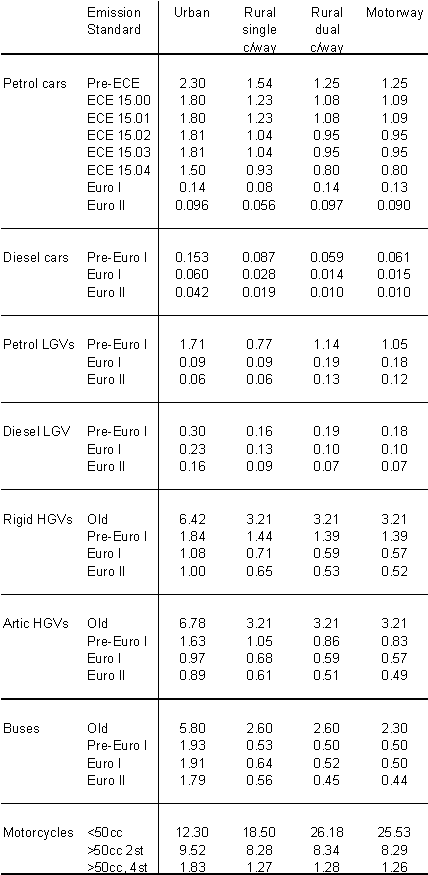
Table 17 NOx Emission Factors for Road Transport (in g/km)
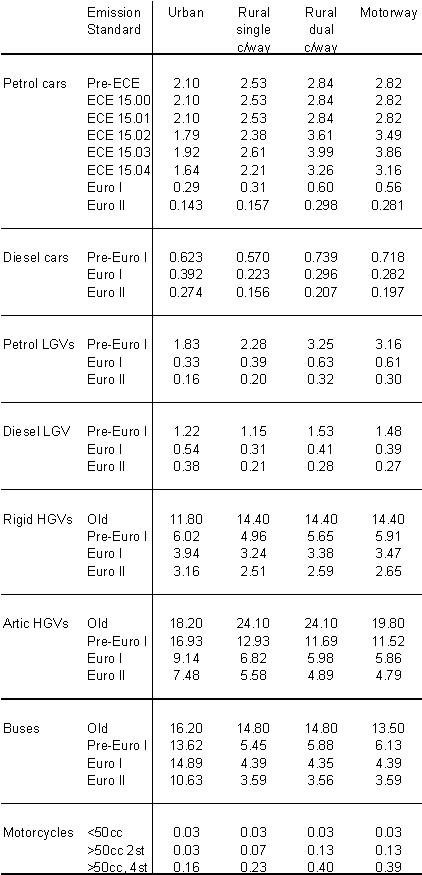
Table 18 CO Emission Factors for Road Transport (in g/km)
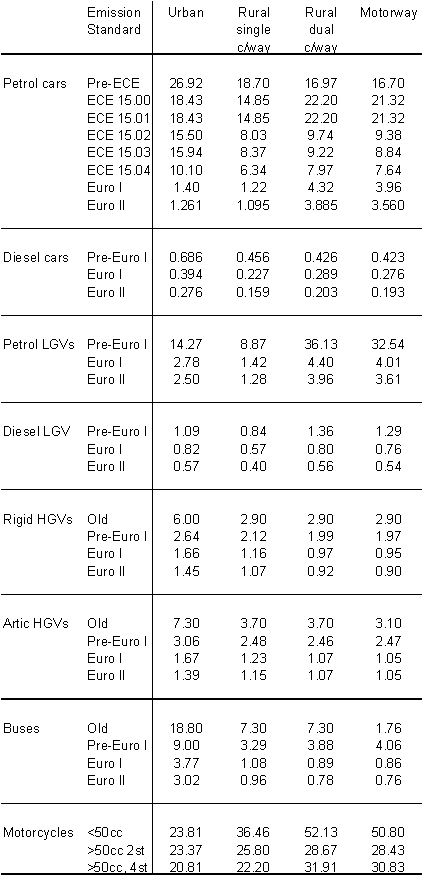
Table 19 Benzene Emission Factors for Road Transport (in mg/km)
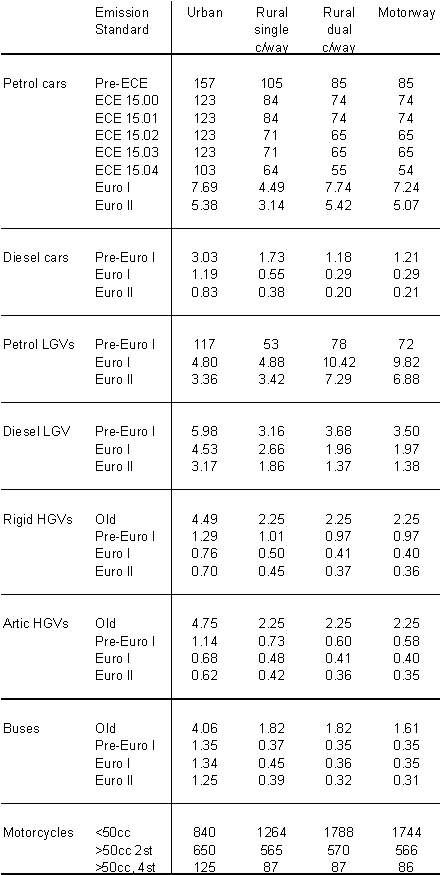
Table 20 1,3-Butadiene Emission Factors for Road Transport (in mg/km)
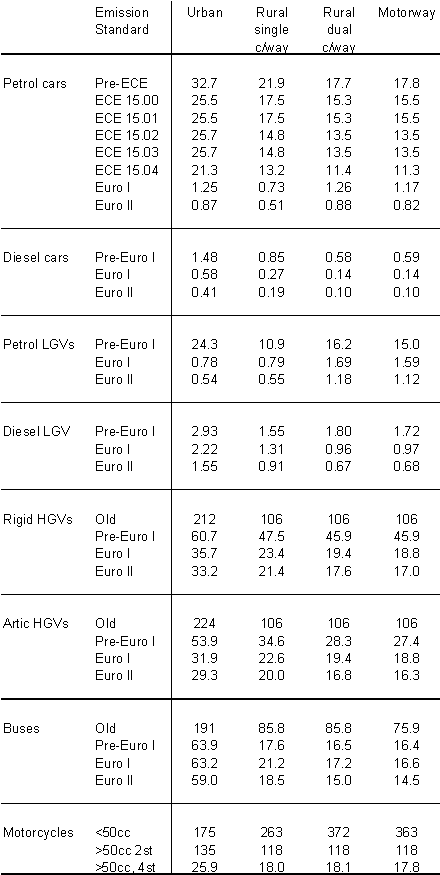
Table 21 Methane Emission Factors for Road Transport (in g/km)
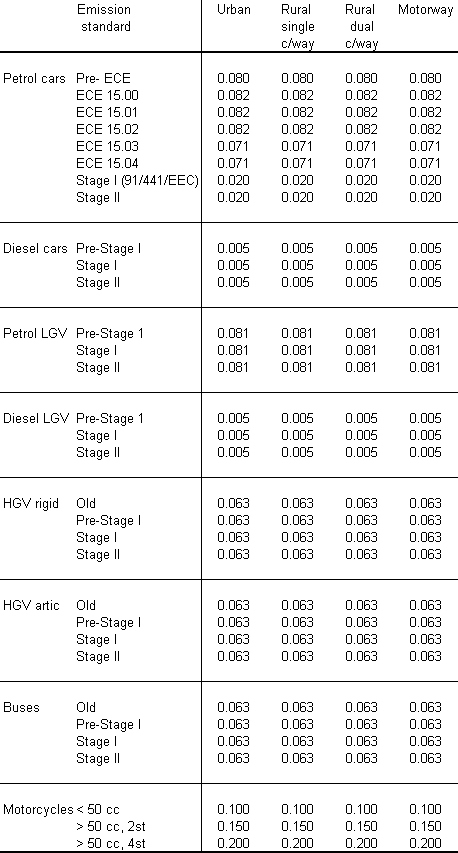
Table 22 N2O Emission Factors for Road Transport (in g/km)
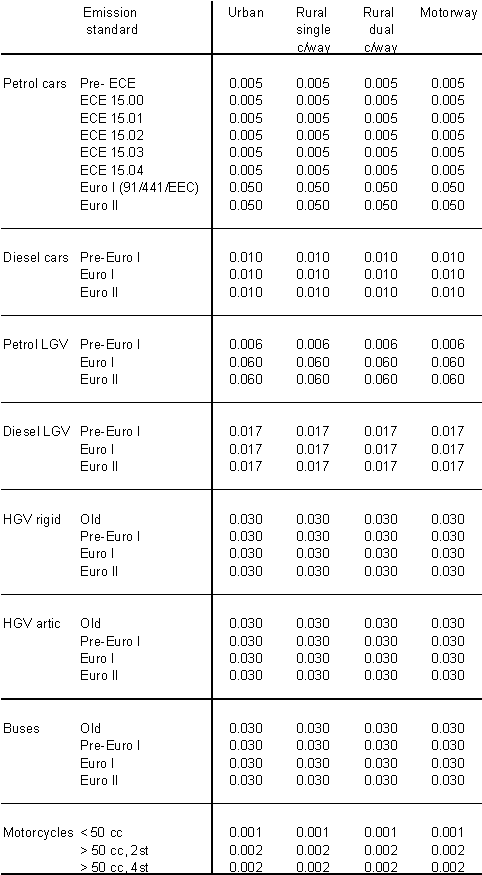
Table 23 PM10 Emission Factors for Petrol Vehicles (in g/km)
|
Leaded |
Unleaded without TWC |
Unleaded with TWC |
|
|
Cars |
0.06 |
0.02 |
0.01 |
|
LGVs |
0.08 |
0.04 |
0.02 |
|
% petrol car kms in 1999 |
13% |
24% |
63% |
Table 24 PM10 Emission Factors for Diesel Vehicles (in g/km) using diesel fuel with up to 500ppm sulphur content
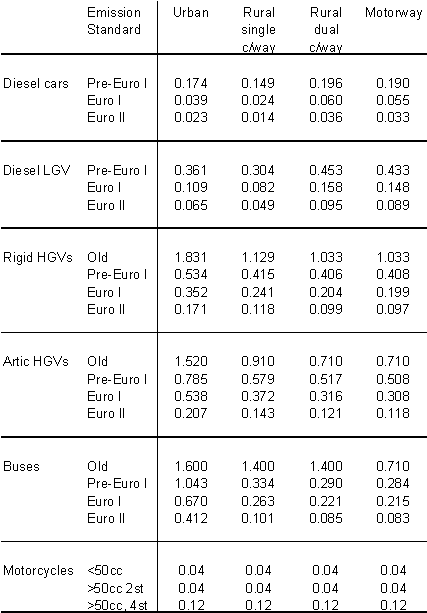
Table 25 Benzo(a)pyrene Emission Factors for Petrol Cars and a Small Diesel HGV (in m g/km)
|
Emission factor (m g/km) |
|
|
Petrol car without a catalyst |
21.9 |
|
Petrol car with a catalyst |
1.1 |
|
Rigid HGV (equivalent to pre-Euro I)* |
21.9 |
*
Emission factor assumed to be for urban speeds. For other diesel vehicle types and other road types or speeds, estimate by scaling according to the ratio of PM emission factors.Table 26 Equations for diurnal, hot soak and running loss evaporative emissions from vehicles with and without control systems fitted
|
Emission factor |
Units |
Uncontrolled vehicle |
Carbon canister controlled vehicle |
|
Diurnal loss (DL) |
g/vehicle.day |
1.54 * (0.51*Trise + 0.62*Tmax + 0.22*RVP - 24.89) |
0.3 * uncontrolled vehicle emissions |
|
Hot soak (HS) |
g/vehicle.trip |
exp(-1.644 + 0.02*RVP + 0.0752*Tmean) |
0.3 * exp(-2.41 + 0.02302*RVP + 0.09408*Tmean) |
|
Running loss (RL) |
g/vehicle.km |
0.022 * exp(-5.967 + 0.04259*RVP + 0.1773*Tmean) |
0.1 * uncontrolled vehicle emissions |
where:
Trise = diurnal rise in temperature in oC
Tmax = maximum daily temperature in oC
Tmean = annual mean temperature in oC
RVP = Reid Vapour Pressure of petrol in kPa